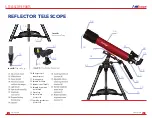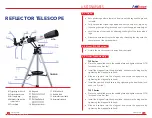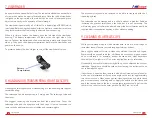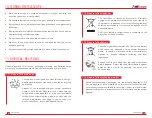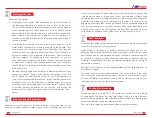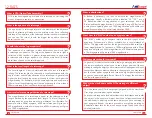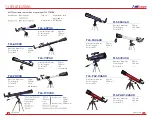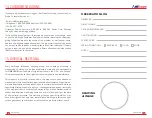
amscope.com
amscope.com
The aperture of a telescope is what determines how much light
a telescope can observe. The larger the aperture, the more light is
collected, which results in a greater image resolution. In short, with
a telescope with a larger aperture, you can see more detail & better
detail than the one with a smaller aperture.
?
12. FAQ’S
OTA is the housing and optical train of a telescope; not including the
mount, diagonal, eyepiece, or accessories.
What is OTA (Optical Tube Assembly)?
The aperture of a telescope refers to the diameter of the objective
lens (for a refracting telescope) or the primary mirror (for a reflecting
telescope). The aperture of the telescope determines how much detail
you can see. The rule of thumb: the bigger the aperture, the more
detail you can see.
What is the aperture of a telescope?
?
?
Should I choose the larger aperture?
?
The focal length of a lens is determined when the lens is focused at
infinity. The focus length of a telescope is usually associated with the
angle of view and the magnification of the telescope. In general, the
higher the focal length, the narrower the angle of view, but higher the
magnification. For example, with the same aperture and eyepiece, a
700mm focal length telescope will have a wider angle of view than a
900mm telescope, but it will have less magnification.
What is the focal length of a telescope?
?
The magnification of a telescope is equal to the telescope's focal
length divided by the eyepiece’s focal length. The focal length of a
telescope and an eyepiece are usually measured in millimeters. For
example, with a 20mm eyepiece, a 900mm telescope will give you a
45X magnification; with a 6mm eyepiece, a 900mm telescope will give
you 150X magnification.
How to calculate the magnification of a telescope?
?
This is because your OTA is not properly aligned with the viewfinder.
First, align your setup during the daytime.
Point your telescope at a land object that is at a far distance and center
the object in the eyepiece. Adjust view finder alignment screws till
the viewfinder is pointing at the same object you have centered in
your eyepiece. Repeat the same procedure at night by pointing at
a celestial object such as the moon and you might need to do some
small adjustments.
Why are the viewfinder and the OTA pointing at a different
object?
?
A Barlow in astronomy is a lens to increase the magnification of
a telescope. Usually, a Barlow would be labeled “2X,” “3X,” etc. a
2X Barlow doubles the magnification of your telescope, and a 3X
Barlow trebles the magnification. For example, using a 2X Barlow on
a setup that originally gives you 150X magnification will double your
magnification making the overall magnification 300X.
What is aBarlow lens?
?
The “MM” number on an eyepiece refers to the focal length of the
eyepiece. For example, a 25mm eyepiece has a focal distance of
25mm. The bigger the number, the longer the focal, which results in a
lower magnification. For instance, a 1000mm telescope with a 25mm
eyepiece will give you a 40X magnification; a 1000mm telescope with
a 10mm eyepiece will give you 100X magnification.
What does the "MM" number on an eyepiece mean?
?
In general, it is better to start with a lower power eyepiece because
the lower magnification allows you to see a larger portion of the sky
making locating the object you are interested in viewing easier. As you
center the object you want to observe in the eyepiece, you may switch
out the lower power eyepiece and insert the higher power eyepiece
so you can see more details. Rule of thumb: The larger the number is,
the lower the power will be.
Which eyepiece should I start with?
21
22





